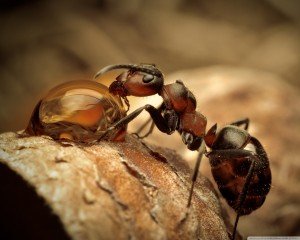Karınca Yaşam Evresi
Karınca 
Siyah bahçe karıncası (Lasius niger) ve firavun karınca (Monomorium pharaonis) en fazla karşılaşılan türlerdir.Her iki tür de yiyecek arayışları nedeni ile problem yaratmaktadırlar.Firavun karınca, sağlık açısından büyük risk taşımaktadır. Genellikle kirli yerlerde (örn. kanallarda) bulunduklarından dolayı, kolaylıkla hastalık mikrobu taşıyabilirler.
Özellikle hastanelerde bulunmaları çok büyük problem yaratmaktadır
Siyah Bahçe Karıncası
| Latince adı: | Lasius niger |
| Uzunluk: | 2 - 12 mm |
| Renk ve özellikleri: | İşçi karıncalar 2 - 5 mm unuluğunda ve koyu kahverengi/siyah renktedirler. Kraliçe karıncaların uzunlukları 12 mm’yi bulabilir ve kahverengi renktedirler. |
| Alışkanlıkları ve yaşam alanları: | Siyah karıncalar, dışarıda yuvalanırlar. Genellikle yiyecek ve su bulmak için binaların içlerine girerler ve ancak çok ciddi sıkıntı yaratmaları durumunda kontrol gerekli olur. Her yuvada bir kraliçe karınca olur. |
| Üreme oranı: | Bir siyah karınca yuvasında yalnızca bir kraliçe karınca bulunur ve yuvada yaklaşık 5000 işçi karınca vardır. Kraliçe karınca 12 yıl kadar yaşabilir. Yaşam süresi 50 – 70 gündür. |
Firavun Karınca
| Latince adı: | Monomorium pharaonis |
| Uzunluk: | 1,5 - 5 mm |
| Renk ve özellikleri: | İşçi karıncalar 1,5 – 2 mm unuluğunda ve sarı-kahverengi renktedirler. Kraliçe karıncalar 3,6 – 5 mm uzunluğundadırlar ve koyu kırmızı renktedirler. Kanatları vardır, ancak uçamazlar. |
| Alışkanlıkları ve yaşam alanları: | Ilık, nemli ortamlara ihtiyaç duyarlar, bu nedenle çoğu zaman binaların içinde bulunurlar. Ilık iklimlerde istila dışarıda olabilir. Bir çok iç mekanda istila olabilir. Bir yuvada birden çok kraliçe karınca vardır ve bu nedenle istila hızla yayılabilir. |
| Yaşam döngüleri: | 38 – 45 gün |
| Üreme oranı: | Bir firavun karınca hayatı boyunca 400'den fazla yumurta bırakabilir. |
